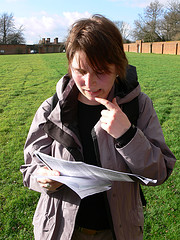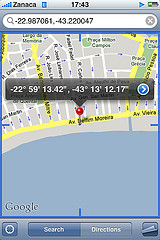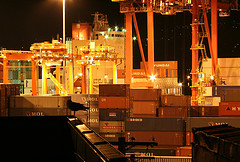 Like many naturalists, I’ve always been fairly fascinated by ants – their industrious sense of purpose, their ability to collaborate as a single metaorganism, and so on. Greater minds than myself have often wondered how they navigate over wide areas so effectively, and now an answer has been unearthed: ant antennae incorporate magnetic minerals that may form part of an insectoid GPS system. [image by Arthur Chapman]
Like many naturalists, I’ve always been fairly fascinated by ants – their industrious sense of purpose, their ability to collaborate as a single metaorganism, and so on. Greater minds than myself have often wondered how they navigate over wide areas so effectively, and now an answer has been unearthed: ant antennae incorporate magnetic minerals that may form part of an insectoid GPS system. [image by Arthur Chapman]
“The incorporation of minerals probably starts as soon as ants start getting in touch with soil,” she added, explaining to Discovery News that her team found ultra fine-grained crystals of magnetic magnetite, maghemite, hematite, goethite, and aluminum silicates in ant antennae. These particles could make a “biological compass needle” that drives ant GPS.
[…]
Our planet is magnetized, likely due to rotational forces of liquid iron in Earth’s core. Although the resulting magnetic field is one-twenty thousandth as strong as a refrigerator magnet, ants appear to “perceive the geomagnetic information through a magnetic sensor (the dirt particles), transduce it in a signal to the nervous system and then to the brain,” she said.
Not all ants may use this particular system. Desert ants, for example, appear to have evolved special eyes that detect skylight polarization, which they then use to find their way around their sandy habitat. Magnetic particles, however, have been detected in many fish, birds, butterflies, flies, bees, bats, mole rats, newts, sea turtles and spiny lobsters, suggesting these animals find their way like the Brazilian ants do.
Ain’t nature wonderful?
I wonder if perhaps we humans have a similar ability lying dormant in our bodies, shoved aside by evolutionary pressures as unnecessary since we stopped being roaming bands of primates and began to settle in stable locations. Perhaps it could be reawakened, or simply installed from scratch by some deft ribofunk biohacking? Imagine a post-fuel future where we have an entire and recently re-greened planet to roam on foot – how wonderful to set out with no map besides the tiny magnets buried in your brain!
 Got a GPS in your car? Well, I hope you’ve not become too reliant on it and totally lost the ability to use old-fashioned road maps, because
Got a GPS in your car? Well, I hope you’ve not become too reliant on it and totally lost the ability to use old-fashioned road maps, because  Over at Wired last week, they ran
Over at Wired last week, they ran  In his writings on ‘cyborg urbanisation‘,
In his writings on ‘cyborg urbanisation‘,  Nothing represents the ubiquity of global trade better than
Nothing represents the ubiquity of global trade better than